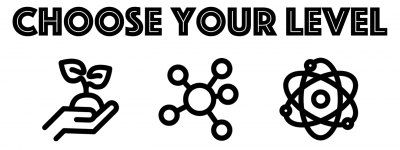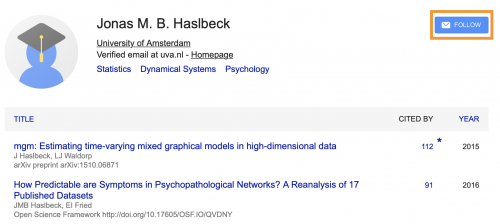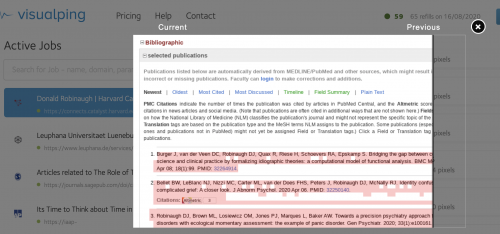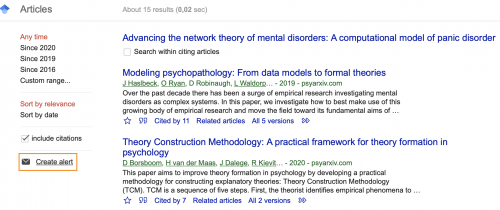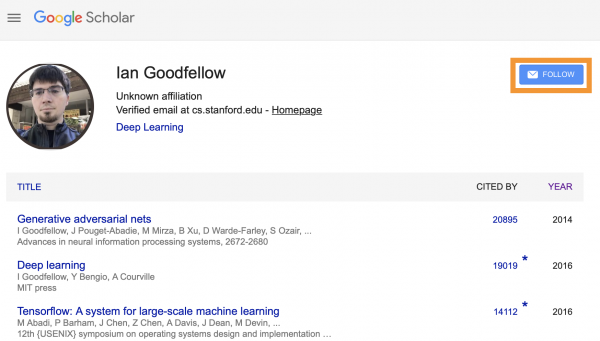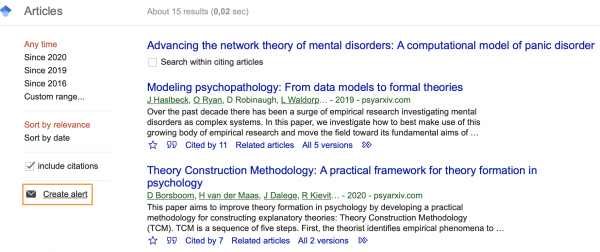Difference between revisions of "Staying on top of research"
Lisagotzian (talk | contribs) |
Lisagotzian (talk | contribs) |
||
| Line 40: | Line 40: | ||
* Twitter | * Twitter | ||
| + | Let's say I found this paper on a computational model for '''Panic Disorder'''. I am very interested in computational models and the network approach they chose seems to be exactly what I was looking for. | ||
| + | |||
| + | [[File:PanicPaper.png|frameless|700px|center]] | ||
| + | |||
| + | |||
| + | |||
| + | |||
| + | |||
| + | |||
| + | After having decided I want to follow this work, I have different options: | ||
| + | {| class="wikitable" | ||
| + | |- | ||
| + | ! !! Google Scholar !! Visualping | ||
| + | |- | ||
| + | | '''Authors''' || Jonas Haslbeck, the second author, seems to publish more on this topic. I therefore choose to follow his work. I found him on [https://scholar.google.com/citations?hl=en&user=jmFh_isAAAAJ '''Google Scholar''']. I can then click on the follow button to receive email alerts whenever he publishes an exciting new paper. | ||
| + | |||
| + | [[File:GoogleScholarHaslbeck.png|500px|thumb|Jonas Haslbeck's Google Scholar Profile.]] | ||
| + | |||
| + | || Sometimes, authors don't have a Google Scholar profile you can follow. This is the case for the first author, Donald Robinaugh. I therefore decide to monitor changes on his website using services like [https://visualping.io '''visualping''']. I can search for the author's institutional webpage or their private webpage where their newest publications are listed. | ||
| + | |||
| + | [[File:VisualpingEnterWebiste.png|center|500px|thumb|Enter the website in [https://visualping.io visualping]...]][[File:VisualpingFollow.png|center|500px|thumb|... and keep track whenever anything changes.]] | ||
| + | |- | ||
| + | | '''Papers''' || Next on, you want to follow the paper itself. I see it as a key to my work so every related work is also potentially interesting for me. I found the paper on Google Scholar, clicked on who cited it and created an email alert. | ||
| + | |||
| + | [[File:GoogleScholarPaper.png|500px|thumb|center|Click on who cited the paper...]] | ||
| + | [[File:GoogleScholarPaperEmail.png|500px|thumb|center|... and create an email alert.]] | ||
| + | |||
| + | || visualping | ||
| + | |- | ||
| + | | '''Journals''' || Google Scholar || visualping | ||
| + | |} | ||
| + | |||
| + | {| class="wikitable" | ||
| + | |- | ||
| + | ! !! Feedly !! Twitter | ||
| + | |- | ||
| + | | '''Authors''' || feedly || There's a whole community of scientists on Twitter. Authors share their recent papers and discuss other people's research below their tweets. The authors that you'd follow on Google Scholar and Visualping you can also follow there. | ||
| + | While Google Scholar and Visualping send you email alerts, Twitter requires you to become active. Make it a habit to scroll through science twitter, maybe attached to whenever you scroll through other social medias. Maybe even create an extra account for this so you can safely follow scientists without them reading potential private tweets :-) Science Twitter awaits you, and it doesn't judge if on top, you also follow your favourite non-related NASA scientist. | ||
| + | |- | ||
| + | | '''Papers''' || feedly || Twitter | ||
| + | |- | ||
| + | | '''Journals''' || feedly || Twitter | ||
| + | |} | ||
| + | |||
| + | |||
| + | |||
| + | |||
| + | OLD | ||
=== Where to follow authors === | === Where to follow authors === | ||
When an author keeps popping up in your research, it might be a good idea to follow their current work. Depending on where they are present, you have different ways to do so: | When an author keeps popping up in your research, it might be a good idea to follow their current work. Depending on where they are present, you have different ways to do so: | ||
| Line 47: | Line 95: | ||
| − | 2. [https://visualping.io '''Visualping''']: | + | 2. [https://visualping.io '''Visualping''']: |
| − | |||
| − | |||
| − | |||
| − | |||
| − | |||
| − | |||
| − | 3. '''Twitter''': There's a whole community of scientists on Twitter. Authors share their recent papers and discuss other people's research below their tweets. The authors that you'd follow on Google Scholar and Visualping | + | 3. '''Twitter''': There's a whole community of scientists on Twitter. Authors share their recent papers and discuss other people's research below their tweets. The authors that you'd follow on Google Scholar and Visualping you can also follow there. |
While Google Scholar and Visualping send you email alerts, Twitter requires you to become active. Make it a habit to scroll through science twitter, maybe attached to whenever you scroll through other social medias. Maybe even create an extra account for this so you can safely follow scientists without them reading potential private tweets :-) Science Twitter awaits you, and it doesn't judge if on top, you also follow your favourite non-related NASA scientist. | While Google Scholar and Visualping send you email alerts, Twitter requires you to become active. Make it a habit to scroll through science twitter, maybe attached to whenever you scroll through other social medias. Maybe even create an extra account for this so you can safely follow scientists without them reading potential private tweets :-) Science Twitter awaits you, and it doesn't judge if on top, you also follow your favourite non-related NASA scientist. | ||
Revision as of 11:47, 24 July 2020
Why & When
As an aspiring scientist, it is important to follow the current discussions in science. Staying on top of research is an essential skill that will enhance your science game significantly. Because that's the gist: There is more to science than searching for terms in Google Scholar.
Ultimately, you want to:
- identify key papers that are relevant for your research and read the papers that cite these key papers
- identify key authors in your field and follow whatever they publish next
- identify key journals in your field that have a high rating (so are being cited frequently) and therefore publish the most important news in your field
The Beginner Level
You have just started out with your study program and want to understand research as such. You may have recently found out that journals exist and that journal ratings are a thing. On this level, you could follow:
- The journals "Nature" and "Science" are the "BILD" newspaper of science. They tend to have rather sensational titles, feature mostly short papers but also report the main news. (Now that I think about it, they are probably a bit better than BILD, but that's just on the side.)
- ...
The Advanced Level
You've understood the game of science and have written your first few papers for your degree program. This means you levelled up! Now it's time to follow some general resources in your field.
These resources can be very influential authors and journals. For Computer Science disciplines, you'll also find that conferences play a major role as new results get published faster. This being said, for Machine Learning, the following resources are important:
- International Conference of Machine Learning (ICML)
- NeurIPS Conference
- Knowledge Discovery and Data Mining Conference (KDD)
- Machine Learning Journal (MLJ)
- Data Mining and Knowledge Discovery (DAMI)
- Journal of Machine Learning Research (JMLR)
The Expert Level
At this stage, you know where you are going in science and have identified your research niche. You want to become an expert in that niche? Well, you need to stay uptodate on a granular level:
Different tools allow you to follow the authors, papers and journals you just identified. The following services and apps are your friend:
- Google Scholar Alerts
- Visualping
- Feedly
Let's say I found this paper on a computational model for Panic Disorder. I am very interested in computational models and the network approach they chose seems to be exactly what I was looking for.
After having decided I want to follow this work, I have different options:
| Google Scholar | Visualping | |
|---|---|---|
| Authors | Jonas Haslbeck, the second author, seems to publish more on this topic. I therefore choose to follow his work. I found him on Google Scholar. I can then click on the follow button to receive email alerts whenever he publishes an exciting new paper. | Sometimes, authors don't have a Google Scholar profile you can follow. This is the case for the first author, Donald Robinaugh. I therefore decide to monitor changes on his website using services like visualping. I can search for the author's institutional webpage or their private webpage where their newest publications are listed.
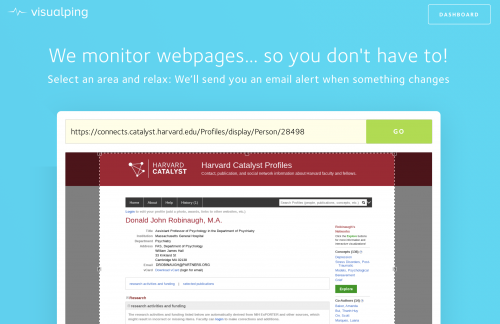
Enter the website in visualping...
|
| Papers | Next on, you want to follow the paper itself. I see it as a key to my work so every related work is also potentially interesting for me. I found the paper on Google Scholar, clicked on who cited it and created an email alert. | visualping |
| Journals | Google Scholar | visualping |
| Feedly | ||
|---|---|---|
| Authors | feedly | There's a whole community of scientists on Twitter. Authors share their recent papers and discuss other people's research below their tweets. The authors that you'd follow on Google Scholar and Visualping you can also follow there.
While Google Scholar and Visualping send you email alerts, Twitter requires you to become active. Make it a habit to scroll through science twitter, maybe attached to whenever you scroll through other social medias. Maybe even create an extra account for this so you can safely follow scientists without them reading potential private tweets :-) Science Twitter awaits you, and it doesn't judge if on top, you also follow your favourite non-related NASA scientist. |
| Papers | feedly | |
| Journals | feedly |
OLD
Where to follow authors
When an author keeps popping up in your research, it might be a good idea to follow their current work. Depending on where they are present, you have different ways to do so:
1. Google Scholar: find the author's Google Scholar profile, eg. in this case Ian Goodfellow's. Click on the follow button to receive email alerts whenever he publishes an exciting new paper.
2. Visualping:
3. Twitter: There's a whole community of scientists on Twitter. Authors share their recent papers and discuss other people's research below their tweets. The authors that you'd follow on Google Scholar and Visualping you can also follow there. While Google Scholar and Visualping send you email alerts, Twitter requires you to become active. Make it a habit to scroll through science twitter, maybe attached to whenever you scroll through other social medias. Maybe even create an extra account for this so you can safely follow scientists without them reading potential private tweets :-) Science Twitter awaits you, and it doesn't judge if on top, you also follow your favourite non-related NASA scientist.
Where to follow papers
Next on, you want to follow papers. You've identified a paper everyone seems to be citing and you want to keep track of who cites it in the future as well. Let's take a paper that developed a computational model for Panic Disorder. As this is very specific to my work, I have a range of possibilities to follow this paper:
1. Google Scholar: find the paper on Google Scholar, click on who cited it and create an email alert.
2. Native Websites:
Where to follow journals
Identify key papers that are relevant for your research and follow it on Google Scholar so every time someone cites it, you'll get an email alert
Identify key authors in your field and follow them on Google Scholar or track changes on their websites
Identify key journals in your field (ask your professor for journals to follow) and follow them on feedly and/or Google Scholar more for beginner's level: How to identify these resources? How to read paper: scan abstract, research is about papers + the references Link on how to do research
Do it as a table?
Links & Further reading
- Icons for "Choose Your Level" are designed by lagotdesign and taken from: https://thenounproject.com/lagotdesign/collection/lagotline-science/
- The Visualping icon: Salager / CC BY-SA (https://creativecommons.org/licenses/by-sa/4.0)
